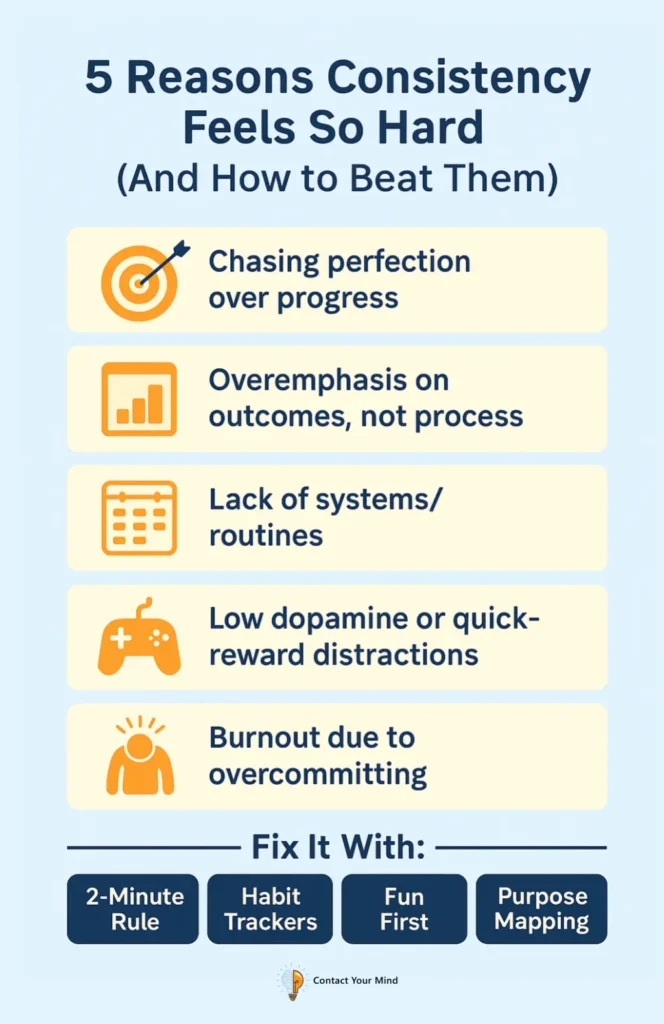Last Updated: July 27, 2025
Let’s be honest, staying consistent is tough. We all start with good intentions: a new workout routine, a daily journal, healthier eating or maybe even a side project that we are passionate about. But a few weeks in, life gets busy. We miss one day, then another and before we know it, we’re back where we started.
It’s frustrating, especially when you see others making steady progress. You might even wonder, “What’s wrong with me?” But the truth is, you’re not broken, your system might be.
In this article, let’s break down why consistency is hard. It’s not because you’re lazy or lack discipline, but because of how our brains and environments work. More importantly, this blog provides real, practical strategies to help you stay consistent and build habits that last for long.
Why We Struggle with Consistency?
Prefer visuals? Here’s a quick breakdown before we dive deep.

We Focus Too Much on Outcomes
One of the biggest reasons people give up so early is because they only focus on the end results. Let’s say you want to lose 10 kilos, write a book or get 10,000 followers on social media. These are great goals, but they’re often far away. So when you work hard and don’t see immediate results, it’s easy to get discouraged.
Let’s take an example: There’s a boy named Raj. He wanted to build a morning routine to become more productive. For two weeks, he woke up early and started journaling his goals. But when he didn’t feel more productive right away, he stopped.
The problem? He was expecting instant results.
What to do instead: Focus on the process, not just the outcome. Ask yourself, “What can I do today that aligns with my goal?” If you want to be a writer, focus on writing 200 words a day. If you want to get fit, focus on moving your body daily.
“Fall in love with the process, and the results will come.”
– Eric Thomas
We Rely on Motivation Much, But Not Systems
Motivation is like a spark, it gets you started, but it doesn’t last long. You might feel super motivated after watching an inspiring YouTube video or reading a self-help book. But what happens the next day, when you’re tired or stressed?
Most people rely on motivation to keep them going. That’s a mistake.
Real change comes from systems, not feelings. Systems are routines, checklists, calendars that keep you on track even when motivation fades.
For example, instead of saying, “I’ll work out if I feel like it,” create a system: “Every Monday, Wednesday, and Friday at 7 AM, I go for a walk, no matter what.” You don’t have to think about it, it becomes a part of your routine.
Our Brain Struggles With Change
Neurologically, our brains are there to keep us safe, it favors survival mechanisms over growth processes. The brain’s default setting is survival, not self-improvement. This means they prefer familiar routines, even if it no longer supports our growth.
Imagine trying to switch from scrolling Instagram in bed to reading a book before sleep. Even if you know reading is better for your mind, your brain craves the dopamine hit from scrolling. It resists the change because it feels uncomfortable.
How to deal with it: Don’t try to change everything at once. Start small. When something is easy, your brain feels less threatened. That’s where the 2-minute rule helps.
The 2-Minute Rule: A Tiny Habit That Changes Everything
James Clear introduced the 2-minute rule in his book Atomic Habits. The idea is simple: Start any new habit by doing it for just two minutes.
It might sound silly. How can two minutes make a difference? But it works because it helps you overcome the biggest obstacle to consistency, that is starting.
Here’s how it looks:
- Want to journal every night? Start by writing one sentence.
- Want to build a reading habit? Read one page
- Want to exercise daily? Just put on your workout clothes.
The goal isn’t to be perfect. It’s to make starting so easy that it’s impossible for you to say no.
Over the time, these two-minute starts to turn into longer routines naturally.
Know more about it here – Why 2 Minutes Is All You Need to Beat Procrastination?
How to Build Consistency with Habit Stacking?
Another powerful method for building consistency is habit stacking. It involves attaching a new habit to something you already do every day.
For example:
- After you brush your teeth, do 5 push-ups.
- After you pour your morning coffee, write your to-do list.
- After you return from work, stretch for 5 minutes.
Why Habit Stacking works: Your brain already recognizes the original habit, so it’s easier for your brain to remember the new one. Think of it like adding a trailer to a truck, the truck (old habit) pulls the trailer (new habit) along.
Try writing down 2 to 3 existing routines and think about what small, helpful behavior you could “stack” on top of them.
Get to know more about it here – Master Productivity with Habit Stacking
The “Never Miss Twice” Rule
We all fall off track. Maybe you were sick, traveling or just overwhelmed. Missing one day is no big deal.
But missing twice starts a new habit, the habit of skipping.
The solution? The “Never Miss Twice” rule.
Let’s say you didn’t journal yesterday. That’s okay. Just make sure you do it today. This mindset stops the feeling of guilt and keeps you moving forward.
It’s about progress, not perfection.
Case Study: Priya wanted to build a meditation habit. She used a calendar to track it daily. Whenever she missed a day or two, she didn’t let it become three or more. Even after a busy week, she got back on track. That mindset helped her build a 90-day streak!
Make Your Routine Fun or Meaningful
Let’s be real, most people quit because they’re bored or disconnected from why they started.
If something feels like a burden, you’ll eventually give it up. But when it’s fun, creative or deeply meaningful, it becomes something you really want to do.
Make your habits enjoyable:
- Add music to your morning routine
- Listen to a podcast while walking
- Join a group or community doing the same habit
Or, make them meaningful:
- Connect the habit to a bigger purpose. “I’m exercising to be healthy for my kids.”
- Reflect on the long-term impact. “This journal will help me understand myself better over time.”
Redesign Your Environment
We often feel this unimportant and overlook this. But your environment plays a huge role in shaping your behavior.
If your phone is on your desk, you’ll check it. If cookies are on the counter, you’ll eat them. If your workspace is cluttered, you’ll avoid sitting down.
Redesign your space to support your habits:
- Want to read more? Put a book on your pillow.
- Want to drink more water? Keep a bottle on your desk.
- Want to sleep early? Keep devices out of the bedroom.
The easier it is to do something, the more likely you’ll do it.
Forgive Yourself, Then Start Again
One of the biggest killers of consistency is shame. When we mess up, we often think, “I’ve failed. What’s the point of trying again?”
But consistency isn’t about never messing up, it’s about not quitting when you do.
Be kind to yourself. Talk to yourself the way you would talk to your friend. Instead of saying, “I’m so lazy,” say, “I had a rough week. I’ll restart today.”
You are a human. And progress is never a straight line.
Wrapping It Up
Consistency may seem like a superpower, but it’s really a skill. One that anyone can learn, including you too. It’s not about being perfect every day. It’s about showing up more often than not, and doing the small things that add up over time.
Start small. Make it easy. Be kind with yourself. And most importantly, keep going.
Quick Recap:
- Focus on process, not perfection
- Use the 2-minute rule to beat procrastination
- Try habit stacking to make new habits stick
- Follow the Never Miss Twice rule
- Make your habits fun and meaningful
- Redesign your environment for success
- Forgive yourself and bounce back quickly



